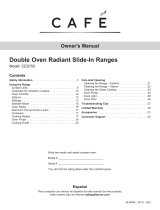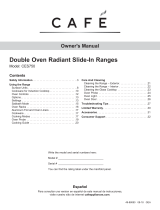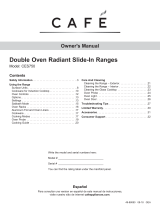
49-80690-5 13
USO DE LA COCINA:&RQWUROHVGHO+RUQR
Controles del Horno
1. Convection Cooking Modes (Modos de Cocción
por Convección): Los modos de cocción por convección
utilizan una circulación de aire incrementada para mejorar el
rendimiento. El tipo de beneficio depende del modo. Su horno
cuenta con los siguientes modos de cocción por convección:
&RQYHFWLRQ%DNH+RUQHDUSRU&RQYHFFLyQ\&RQYHFWLRQ5RDVW
(Asar por Convección). Para más información, consulte la
sección de Modos de Cocción.
2. Traditional Cooking Modes (Modos de Cocción
Tradicionales): Su horno cuenta con los siguientes modos
GHFRFFLyQWUDGLFLRQDOHV%DNH+RUQHDU%URLO+L$VDU$OWR
%URLO/R$VDU%DMR\:DUP&DOHQWDU3DUDPiVLQIRUPDFLyQ
consulte la sección de Modos de Cocción.
3. Clean (Limpieza): El horno cuenta con dos modos de
limpieza: Self Clean (Limpieza Automática) y Steam Clean
(Limpieza con Vapor). Para acceder a información importante
sobre el uso de estos modos, consulte la sección de Limpieza
GHO+RUQR
4. Start (Iniciar): Se deberá presionar para comenzar cualquier
función de cocción, limpieza o por tiempo.
5. Cancel/Off (Cancelar/ Apagar): Cancela TODAS las
funciones del horno, excepto el reloj, el temporizador, el cajón
para calentar y el área para calentar.
6. Cook Time (Tiempo de Cocción): Cuenta el tiempo
de cocción y apaga el horno cuando el tiempo de cocción está
completo. Presione la tecla Cook Time (Tiempo de Cocción),
use las teclas numéricas para programar un tiempo de cocción
en horas y minutos, y luego presione Start (Iniciar). Esto sólo
SXHGHVHUXVDGRFRQ%DNH+RUQHDU&RQYHFWLRQ%DNH+RUQHDU
por Convección), y Convection Roast (Dorar por Convección).
7. Clock (Reloj): Configure el tiempo del reloj del horno.
Mantenga presionadas las teclas 9,0 durante tres segundos o
presione la tecla Set Clock (Configurar Reloj), y luego use las
teclas numéricas para programar el reloj. Presione Start (Iniciar)
para guardar la configuración de la hora.
8. Timer On/Off (Temporizador Encendido/
Apagado): Funciona como un temporizador con cuenta
regresiva: Presione la tecla Timer On/Off (Temporizador
Encendido/ Apagado) y las teclas numéricas para programar
el tiempo en horas y minutos. Presione la tecla Start (Iniciar).
La cuenta regresiva del temporizador se completó. Para apagar
el temporizador, presione la tecla Timer On/Off (Temporizador
Encendido/ Apagado).
9. Delay Time (Tiempo de Retraso): Genera un retraso
FXDQGRHOKRUQRHVHQFHQGLGR8VHHVWDWHFODSDUDFRQILJXUDUHO
momento en que desea que el horno se inicie. Presione la tecla
Delay Time (Tiempo de Retraso) y use las teclas numéricas
para programar la hora del día en que desea que el horno se
encienda y presione Start (Iniciar). Presione el modo de cocción
deseado y la temperatura y luego presione Start (Iniciar). Si lo
desea, también puede ser programado un tiempo de cocción.
6LJDODVLQVWUXFFLRQHVGH&RRN7LPH7LHPSRGH&RFFLyQ
para configurar esta función. Esto sólo puede ser usado con
%DNH+RUQHDU&RQYHFWLRQ%DNH+RUQHDUSRU&RQYHFFLyQ
Convection Roast (Dorar por Convección) y Self-Clean (Limpieza
Automática).
NOTA: Al usar la función de tiempo de retraso, las comidas
que se echan a perder rápidamente, tales como leche, huevos,
pescado, rellenos, ave y cerdo, no se deberán dejar reposar por
más de 1 hora antes y después de la cocción. La temperatura
ambiente estimula el desarrollo de bacterias nocivas. Asegúrese
de que la luz del horno esté apagada, ya que el calor de la
lámpara acelerará el crecimiento de bacterias nocivas.
10. Oven Light(s) (Luz(es) del Horno): Enciende o apaga
la luz(es) del horno.
11. Lock Controls (Controles de Bloqueo): %ORTXHDQ
el control de modo que al presionar las teclas no se activen
los controles. Presione la tecla Lock Controls (Controles de
Bloqueo) durante tres segundos para bloquear o desbloquear
el control. Cancel/Off (Cancelar/ Apagar) siempre está activa,
incluso cuando el control está bloqueado.
12. Warming Drawer (Cajón para Calentar) (en
algunos modelos) o Warming Zone (Área para
Calentar): Mantiene las comidas calientes y cocinadas en
la temperatura para servir. Presione la tecla Warming Drawer/
Warming Zone (Cajón para Calentar/ Área para Calentar).
8VHODWHFODQXPpULFDSDUDVHOHFFLRQDUODFRQILJXUDFLyQGH
temperatura. Presione 1SDUD/RZ%DMR2 para Medium (Medio)
o 3SDUD+LJK$OWR\OXHJRSUHVLRQHStart (Iniciar)'UDZHU
&DMyQHVWiGHEDMRGH2YHQ+RUQR=RQHÈUHDHVWiVREUHOD
placa de cocción.
NOTA: /DWHFOD&DQFHO2II&DQFHODU$SDJDUQRDSDJDOD
IXQFLRQHV:DUPLQJ'UDZHU&DMyQSDUD&DOHQWDUQL:DUPLQJ
=RQHÈUHDSDUD&DOHQWDU3DUDDSDJDUORVSUHVLRQHODWHFOD
Warming Drawer (Cajón para Calentar) o Warming Zone
(Área para Calentar).
13. Probe (Sonda) (en algunos modelos): Monitorea la
temperatura interna de la comida y apaga el horno cuando la
comida alcanza la temperatura programada. Inserte la sonda,
programe el modo de cocción, y programe la temperatura de la
sonda. Para más información, consulte la sección de Modos de
&RFFLyQ/DVRQGDVyORSXHGHVHUXVDGDFRQODVIXQFLRQHV%DNH
+RUQHDU\&RQYHFWLRQ5RDVW'RUDUSRU&RQYHFFLyQ
14. Remote Enable (Acceso Remoto) (en algunos
modelos): El horno debe ser conectado a su red hogareña
antes de usar la tecla Remote Pad (Acceso Remoto). El símbolo
de conectividad indica el estado de la conexión del horno a su
red hogareña.
CÓMO CONECTAR EL HORNO
Off (Apagado) - El horno no está conectado. Abra la aplicación
y luego mantenga presionada la tecla Remote Enable (Acceso
Remoto) durante 5 segundos para iniciar el proceso de
conexión.
Slow flash (parpadeo lento) - El horno está en modo de
búsqueda y está buscando una red.
Solid (Sólido) - El horno está conectado a la red y puede ser
controlado en forma remota a través de un dispositivo móvil
conectado cuando está en funcionamiento, pero no puede ser
iniciado en forma remota.
INICIO DEL HORNO EN FORMA REMOTA
Para poder iniciar el horno en forma remota, presione la tecla
Remote Enable (Acceso Remoto) y la luz que está arriba de la
tecla Remote Enable (Acceso Remoto) se encenderá. El horno
ahora puede ser iniciado en forma remota con un dispositivo
conectado. Abrir la puerta del horno o apagar el mismo hará
que se apague la luz que está arriba de la tecla Remote Enable
(Acceso Remoto). La luz que está arriba de la tecla Remote
Enable (Acceso Remoto) deberá estar iluminada para iniciar
el horno de forma remota. No se requiere la luz que está arriba
de la tecla Remote Enable (Acceso Remoto) para cambiar las
configuraciones del horno o para apagar el mismo.
Luego de usar el horno, recuerde verificar que la luz que está
arriba de Remote Enable (Acceso Remoto) esté encendida, si
desea iniciar un horno de forma remota en el futuro.



































































